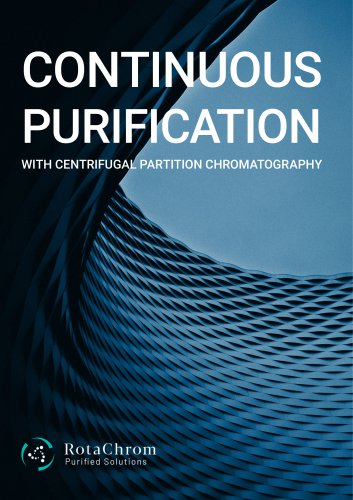 Website:
RotaChrom Technologies LLC.
Website:
RotaChrom Technologies LLC.
Catalog excerpts
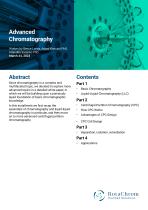
Advanced Chromatography Written by Bence Lovas, Arpad Konczol PhD, Hajnalka Saranko PhD March 24, 2023 Since chromatography is a complex and multifaceted topic, we decided to explore more advanced topics in a detailed white paper, in which we will be building upon a previously layed foundation of basic chromatographic knowledge. In this installment we first recap the essentials of chromatography and liquid-liquid chromatography in particular, and then move on to more advanced centrifugal partition chromatography. • Centrifugal Partition Chromatography (CPC) • Basic Chromatography • Liquid-Liquid Chromatography (LLC) Part 2 • How CPC Works • Advantages of CPC Design • CPC Cell Design Part 3 • Separation, isolation, remediation
Open the catalog to page 1
Basic Chromatographic & Liquid-Liquid Chromatography Basic Chromatography In an LLC system separation takes place based on the differing partitioning behavior of the solutes between the two phases. Since LLC uses a liquid stationary phase, the technique offers many advantages over traditional liquidsolid chromatographic separation techniques. Chromatography is the physical methodology of separating a component from a mixture. In the chromatographic process components are divided into two media: stationary phase and mobile phase. Due to the driving force (which can be pressure difference,...
Open the catalog to page 2
Centrifugal Partition Chromatography (CPC) & How CPC Works Centrifugal Partition Chromatography (CPC) Here VM and Vs are the mobile and stationary phase volumes, respectively, inside the CPC system. Moreover, the ratio of Kd values determined for a pair of components (separation factor or selectivity; e.g., for CoI and its impurities) clearly predicts their separability in the CPC run. Centrifugal Partition Chromatography obeys classical chromatographic rules. It is a liquidliquid preparative chromatographic technique, in which separation occurs between two immiscible liquid solvent...
Open the catalog to page 3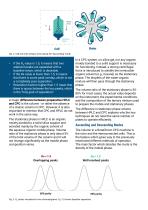
Fig. 2. Cell and rotor design, showcasing the ‘descending’ mode. • If the Rs value is 1.5, it means that two adjacent peaks are separated with a baseline return, which is desirable. • If the Rs value is lower than 1.5, it means that there is some peak overlap, which is not a completely pure separation. • Resolution factors higher than 1.5 mean that there is space between the two peaks, which is the “holy grail of separation”. In a CPC system, no silica gel, nor any organic moiety bonded to a solid support is necessary for functioning. Instead, a strong centrifugal force is introduced to...
Open the catalog to page 4
This is because a liquid mobile phase can be denser or less dense depending on the separation. The mobile phase’s density is of course in comparison to the density of the immobilized stationary phase. This means that the mobile phase must be denser or less dense than the stationary phase. Typically, operating in descending mode gives better separation Operating a RotaChrom CPC device in both modes is possible. However, certain devices require more preparation than other ones. In the case of rCPC, one machine can be operated both ways. It doesn’t need any extra parts or preparations. For the...
Open the catalog to page 5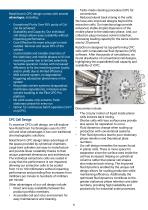
• Tailor-made cleaning procedure (CIP) for convenience. • Reduced eluent back-mixing in the cells. We have also improved designs beyond the extraction cells. Our injection plugs provide enhanced, stable droplet dispersion of the mobile phase to the stationary phase. And, our collection plug increases solvent retention, increasing loading capacityfor the same column size by 20 percent. RotaChrom’s CPC design comes with several advantages, including: • Exceptional Purity Over 95% purity of CoI can be achieved. • Scalability and Capacity: Our individual cell design allows easy scalability...
Open the catalog to page 6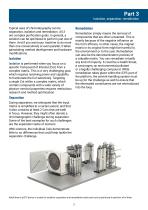
Isolation, separation, remediation Remediation Typical uses of chromatography can be separation, isolation and remediation. All 3 are complex purification goals. In general, a solution can be optimized to perform just one of them. And if you want your machine to do more than one consecutively or even parallel, it takes painstaking method development and hardware modifications. Remediation simply means the removal of components that are often unwanted. This is mainly because of the negative influence on the CoI’s efficacy. In other cases, the original matrix in its original form might be...
Open the catalog to page 7
Applications Elution Isolation of an Antibiotic Oligopeptide (Cyclosporine A) Concentration [mg/ml] Active Pharmaceutical Ingredient (API): Cyclosporine A (CsA) Goal: Purification Cyclosporine A is a cyclic oligopeptide, with a lipid side-chain. It is produced by fermentation. The result of fermentation is usually a mixture of products with closely related structural properties. These are usually purified by classical purification methods: a combination of crystallization and preparative HPLC. To avoid costly two-step purification methods, RotaChrom developed a CPC solution which can...
Open the catalog to page 8
Isolation of Plasma Proteins CoI: Recombinant Human Albumin (rHA) Concentration [mg/ml] Goal: Isolation of the CoI To this day, the Cohn method is the most widely used core fractionation technique for fractionation. However, it comes with high initial investment and maintenance cost. At the end of the study, the resulting rCPC method could isolate rHA with higher than 95% purity and high recovery. Also, this low-temperature process with sequential precipitations induces substantial loss of proteins. Purification of Quercetin Glycosides Concentration [mg/ml] CoI: Quercetin Glycosides...
Open the catalog to page 9
Gergo Ignacz, Robert Orkenyi, Arpad Konczol and Gyorgy Szekely, 2022, ‘Contemporary Chemical Approaches for Green and Sustainable Drugs – 1st Edition: Sustainable separations in pharmaceutical manufacturing’, Book Chapter https://doi.org/10.1016/B978-0-12-8222485.00008-5 Laszlo Lorantfy, Dora Rutterschmid, Robert Orkenyi, David Bakonyi, Jozsef Farago, Gergo Dargo, and Arpad Konczol, 2020, ‘Continuous Industrial-Scale Centrifugal Partition Chromatography with Automatic Solvent System Handling: Concept and Instrumentation’, Organic Process Research & Development, article...
Open the catalog to page 10All RotaChrom Technologies LLC. catalogs and technical brochures
-
Continuous CPC
12 Pages
-
CPC Modeler
12 Pages


